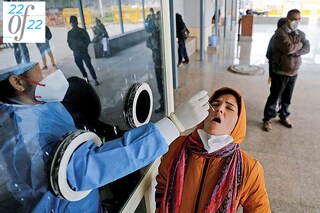Covid-19: Is the worst behind us? Maybe not
As we let our guards down with regard to precautions and vaccinations, experts call for continued surveillance, data-gathering and preparedness


The year 2022 has been a tale of contrasts as far as the Covid-19 pandemic is concerned. In January, there was an aggressive push for vaccinations and boosters, and the threat of the Omicron variant loomed large. Twelve months down the line, most people no longer wear masks. Airports and other public places have also eased restrictions.
Experts attribute this to a host of factors, while also saying this is a good time to strengthen our preparedness for possible variants and outbreaks in the future.
The Omicron variant turned out to be relatively milder and less threatening compared to the earlier Delta for a number of reasons, says K Srinath Reddy, past president and honorary distinguished professor at Public Health Foundation of India (PHFI). These include change in the virus behaviour itself, fairly higher level of acquired immunity from exposure to Alpha and Delta variants earlier on, and also, high level of vaccinations.
“Not many people are getting a serious illness now. Even the number of cases with diagnosed infections has come down," he says, adding that lower hospitalisations and records of severe cases are contributing to relaxations in terms of both masking mandates and vaccinations. “As immunity wanes, people will get infected in larger numbers periodically. But if the same trend continues of the Omicron being relatively milder than its predecessors, then we are unlikely to have the huge burden of severe illness or deaths."
Check Out: Rewind 2022: Year in Review
As of December 8, according to the government’s CoWin platform, India has administered 219 crore doses of Covid-19 vaccines, including 102 crore first doses, 95 crore second doses, and 22 crore booster shots. As per the Covid-19 Vaccine Tracker on December 2, India had approved 12 vaccines, including Covaxin, Covishield, Sputnik V, ZyCovD, Corbevax and Covovax. Apart from Covaxin (by Bharat Biotech) and Covishield (by Serum Institute of India), other vaccines have been approved only for restricted emergency use.
“I think vaccination, both in adults and on the paediatric side, is taking a backseat. The government is no longer emphasising it and the demand has come down," says pharma analyst Vishal Manchanda, senior vice president-institutional research, Systematix, adding that other upsides seen by the pharma sector during the pandemic, like demand for drugs to treat Covid-19, might also not come back.
A Business Standard report in October said India may have wasted a little over 100 million doses of Covid vaccines as of September-end, as the doses were past their shelf life. “Were there no takers of these booster doses or they simply didn’t reach the needy?" the report said, pegging the loss at ₹2,250 crore. “We are not seeing severe infections, which is giving people comfort to not go for routine vaccinations, which also gives comfort to the government," says Manchanda. “Once we see an increase in hospitalisation, we will see a push for vaccinations and boosters again, but that’s not happening now."
While India has not reached optimal vaccine coverage, particularly in terms of boosters, our vaccination efforts have been successful and natural immunity has also been fairly high in the community, says Anant Bhan, a global health, bioethics and health policy researcher. The messaging on the frequency of vaccinations and boosters is also not clear so far. “Coronavirus waves being seen in other countries are not being seen in India, which is also why we are seeing a withdrawal of masking mandates, travel restrictions etc. It has not been worrisome so far, but experience from other countries shows that we should remain watchful of new variants."
This is a good time to think about learnings from the pandemic on surveillance and preparedness, Bhan adds. The focus, according to him, has to be on building resilience in terms of lab capacity, human resources, regular surveillance, and capacity-building in hospitals in case there is a resurgence of cases. There is also a need to ensure that health care equipment bought as part of Covid response are utilised and repurposed. Reddy adds that we must not let our guard down in terms of genome sequencing.
There is, however, a lack of systematic surveillance, says immunologist Satyajit Rath, visiting faculty, Indian Institute of Science Education and Research in Pune. “My sense is that we are not tracking cases even as systematically as we were during 2020-21. Neither is everyone who is symptomatic getting tested, nor apparently are all tests being reliably reported. There is also no systematic sampling-based testing being done on large scale for epidemiological purposes."
Watch here: Rewind 2022: Year in Review All Major Events That Happened This Year
This would lead to problems like not knowing the current state of infections in the community, patterns of the spreads, emergence of new variants, and proportion of community having taken booster doses, Rath says.
Reddy agrees that data metrics like testing, hospitalisation, outpatient facilities have to be well-integrated. “We have to keep a careful watch on the epidemiological pattern of rising infections, clinical patterns of rising hospitalisations and genomic pattern of emerging virus variants. If we do that, we are on relatively safe ground of being prepared to respond should things turn worse," he says. “The right approach is cautious optimism."
First Published: Dec 27, 2022, 11:51
Subscribe Now